| |
|
Monday, April 7 Jacob Goldberg Lecture: Iran versus Israel
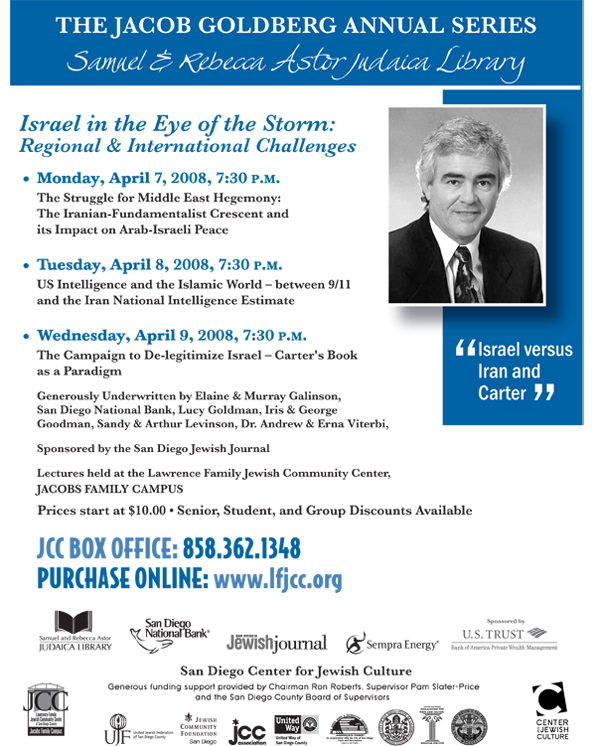
Friday-Sunday, April 11-13 Mountain Chai~Big Boys Getaway
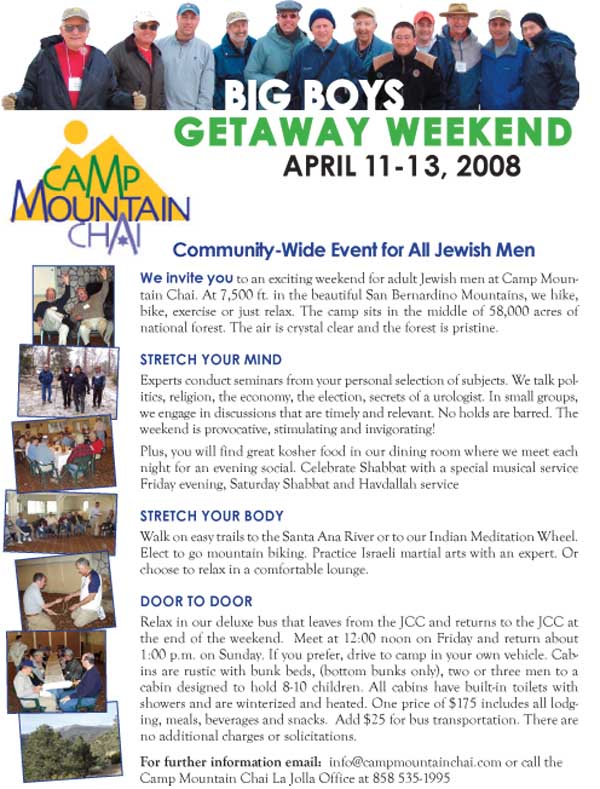
SUNDAY, APRIL 13 Beth Israel~Israel at 60 photo exhibit

Sunday, April 20 Beth Am~Second Night Seder
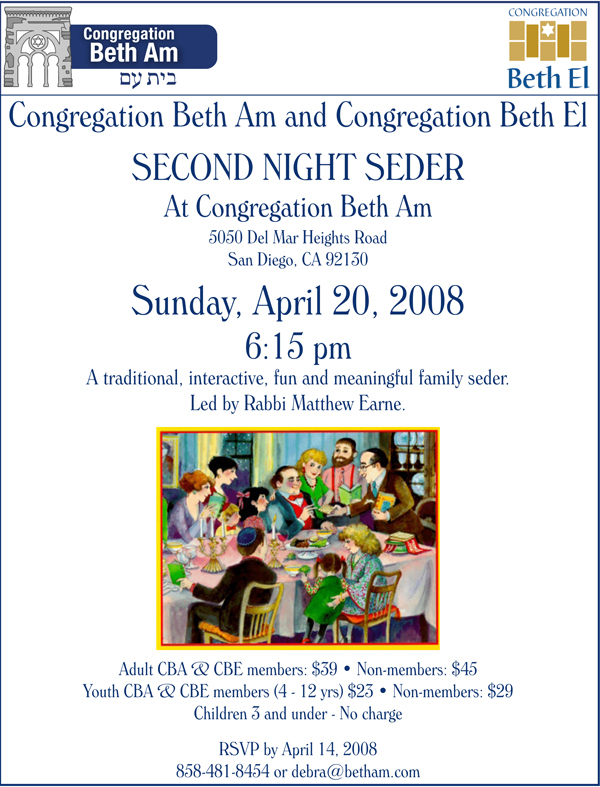
Wednesday, May 28 JFS~Ellen Saks lecture on mental illness
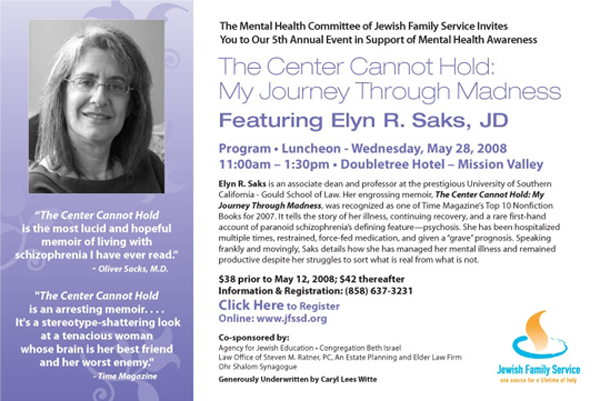


THE JEWISH CITIZEN
Congresswoman offers some Super Sunday advice to those who solicit by telephone
By Donald H. Harrison
 SAN DIEGO—Congresswoman Susan Davis (Democrat, San Diego), who was active in Jewish communal affairs long before she became involved with elective politics, suggested at Super Sunday yesterday that handling unhappy potential United Jewish Federation donors on the telephone is not that much different from dealing with displeased constituents. SAN DIEGO—Congresswoman Susan Davis (Democrat, San Diego), who was active in Jewish communal affairs long before she became involved with elective politics, suggested at Super Sunday yesterday that handling unhappy potential United Jewish Federation donors on the telephone is not that much different from dealing with displeased constituents.
She said that whether the people are calling a congressional office with a complaint, or venting their concerns about the Jewish community, the important thing is to listen, and to let them know that what they say is important and is being heard.
"Tell them you are here to listen," Davis advised. "Ask them, 'what do you need? what is your problem? If you have a complaint, it's important that I hear what you have to say."
The congresswoman--who before going to the House of Representatives had served San Diego on the school board of the San Diego Unified School District—said that if the angry person "feels that you are actually listening, they usually will calm down."
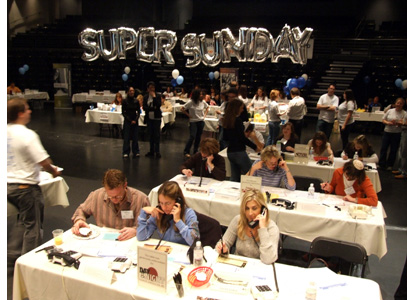 Not long after she spoke words of encouragement to UJF phone bank volunteers at the Lawrence Family JCC, she took to the telephone herself, spending about an hour making calls to people on a list handed to her by Federation staff members. She identified herself as "Susan Davis," but did not call herself "Congresswoman Susan Davis." Not long after she spoke words of encouragement to UJF phone bank volunteers at the Lawrence Family JCC, she took to the telephone herself, spending about an hour making calls to people on a list handed to her by Federation staff members. She identified herself as "Susan Davis," but did not call herself "Congresswoman Susan Davis."
One of the prospects she called had contributed $200 to the UJF the previous year, and agreed to contribute $200 again, she said. But the call Davis said she was most proud of was one in which she chatted with an elderly woman. The woman, who had contributed $5 in 2006, said she was not doing well. Did she need help? Davis inquired. The woman said she was not as bad off as some others, and then said whereas she couldn't afford to give much on her fixed income, she would give $2 to the Federation.
Figuring the cost of postage to the Federation if a pledge reminder had to be sent to the lady by mail, Davis asked her if she would consider sending the check in soon. "She said, 'I'm writing it right now!' So there's $2 in the mail. And I think she felt very good about writing the check. It brightened her day," Davis said.
 Elsewhere in the JCC's David and Dorothea Garfield Theatre, there were other triumphs as volunteers persuaded their fellow Jews to contribute to Federation, which helps the embattled citizens of Israel—particulary in Sha'ar Hanegev, which has been subject to almost daily Kassam rocket attacks from across the Gaza border. UJF also allocates money to such local Jewish organizations as Seacrest Village Retirement Community, Jewish Family Service, Hillel, the Lawrence Family Jewish Community Center, and the Agency for Jewish Education. Elsewhere in the JCC's David and Dorothea Garfield Theatre, there were other triumphs as volunteers persuaded their fellow Jews to contribute to Federation, which helps the embattled citizens of Israel—particulary in Sha'ar Hanegev, which has been subject to almost daily Kassam rocket attacks from across the Gaza border. UJF also allocates money to such local Jewish organizations as Seacrest Village Retirement Community, Jewish Family Service, Hillel, the Lawrence Family Jewish Community Center, and the Agency for Jewish Education.
At one point in the afternoon, Brianne Winters, the Super Sunday chair, announced that Geoff Phillips (photo above) had secured a pledge of $1,000 from a donor who had never given that much to the annual campaign before, but who had contributed a similar amount two years ago in response to the emergency Israel faced during the Second Lebanon War.
 Not all the volunteers who came for two-hour sessions did phone solicitations, as there were opportunities to participate in a variety of other projects. For example, Ashley Mathios and Noa Kempinski (at right) , both 14, were cutting and tying ribbons to tambourines to be used at the UJF Women's Seder to be held this coming Thursday evening at Congregation Beth Israel. The tambourines will be used while singing and dancing in emulation of Miriam and the other Israelite women after they crossed the Red Sea. Not all the volunteers who came for two-hour sessions did phone solicitations, as there were opportunities to participate in a variety of other projects. For example, Ashley Mathios and Noa Kempinski (at right) , both 14, were cutting and tying ribbons to tambourines to be used at the UJF Women's Seder to be held this coming Thursday evening at Congregation Beth Israel. The tambourines will be used while singing and dancing in emulation of Miriam and the other Israelite women after they crossed the Red Sea.
At another table, Joyce Hoffman, Marcy Knopman and Mickie Targum made certain that thank you notes were written to the 275 volunteers who participated in the phonathon, and also distributed post cards for volunteers to send to U.S.Secretary of State Condeleezza Rice, which stated: "The recent war in Israel may be over, but we in san Diego have not forgotten Ehud Goldwasser, Eldad Regev and Gilad Shalit, the Israeli soldiers kidnapped by terrorists. I urge you to do everything in your power to see to the well-being and safe return of these brave young men captured while defending their country."
 Nearby Jonas Dellman, 4, joined his father, Mike Dellman, along with Lauren Rinsky (left) and Arielle Morrison (at right) in drawing Passover designs on shopping bags, and then stuffing the bags with such Passover goodies as matzohs and macaroons. These bags will be delivered to senior citizens who are shut-ins and to refugees in San Diego, said Alexandra Fisch, a UJF staff member who helped coordinate Super Sunday Nearby Jonas Dellman, 4, joined his father, Mike Dellman, along with Lauren Rinsky (left) and Arielle Morrison (at right) in drawing Passover designs on shopping bags, and then stuffing the bags with such Passover goodies as matzohs and macaroons. These bags will be delivered to senior citizens who are shut-ins and to refugees in San Diego, said Alexandra Fisch, a UJF staff member who helped coordinate Super Sunday
In addition to the Americans raising money for Israel, so too did a touring group of communal workers and educators from Sha'ar Hanegev, the partnership region in Israel of the United Jewish Federation. Among those who worked the telephones was Shimon Keren-Zvi, the treasurer of the Sha'ar Hanegev municipality, who has been discussing with Federation officials his city's need to build a rocket-proof school to protect the children. For the most part, Keren-Zvi said he left messages on home answering machines. One person he did reach responded, "not interested!" before hanging up.
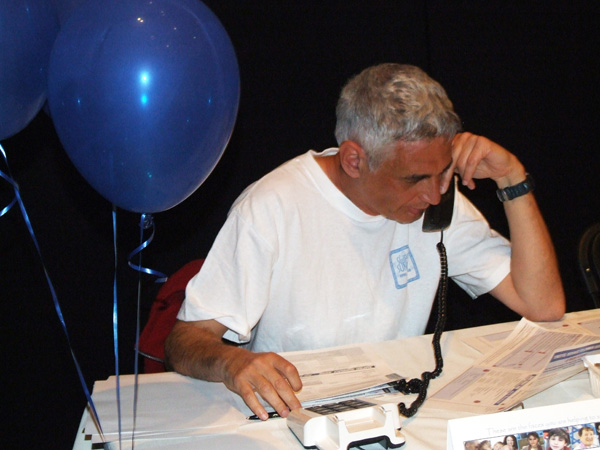
Roberto Weinstein, who led the training session for the Super Sunday session. told the volunteers not to become upset if people refused to make a contribution. "Thank them," he advised. Even if they don't contribute, the people are learning more about the Jewish community and may decide to contribute another day.
While figures for the day's work were not immediately available, one official estimated that the Phonathon would bring in approximately $100,000 before the last solicitation was made.


Why Israel @ 60 is a big deal
By Dov Burt Levy
 SALEM, Massachusetts—Israel@60. No, this is not an email address but rather a logo for all the celebrations surrounding Israel's 60th birthday this year. SALEM, Massachusetts—Israel@60. No, this is not an email address but rather a logo for all the celebrations surrounding Israel's 60th birthday this year.
"What's the big deal?" some have asked. "Wasn't it inevitable that Israel, filled with Jewish talent and common sense, championed by Jews all over the world, would prosper and arrive at 60 or 100 or 120 years in good shape, in better health than people, subject, as we are, to a limited life span?"
Here's the big deal:
Israel's birth was on May 14, 1948, the very day British troops would finally start leaving the country after having guarded the borders since the United Nations voted on November 29, 1947, to establish a Jewish state. Britain tried to bar all defensive military equipment from the fledgling Jewish state, despite the unmistakable warlike intentions of neighboring states.
True to their threats, Egypt, Jordan, Lebanon, Syria and Iraq all attacked Israel the next day, May 15.
No one anywhere thought Israel would easily prevail.
And it was not easy. The war continued off and on until July 21, 1949. Israel lost 4,000 soldiers and over 2,000 civilians of the total Jewish population of 700,000.
Just to show the ferocity and impact of the war between Israel and the five aggressor states, the United States military losses in Iraq last week reached 4,000 in five years of fighting, from an American population of 300 million people. I don't diminish America's sorrow and anger in any way, just want to put Israel's battle for survival in perspective.
Another astounding fact: During the War of Independence, one out of seven Israelis, 100,000 men and women, served in the military.
By no means a certainty, then, that 60 years later Israel would be celebrated for its social and economic history that anyone — historian, economist or interested observer — would have to acknowledge as marvelous and miraculous, fueled by chutzpah and hard work.
Yet, many Jewish-Americans seem to believe that Israel is mostly a poor country with lots of soldiers, sand and trouble.
That completely erroneous view, plus the much-overstated fear of imminent danger to every tourist, is why so many Americans have never visited Israel.
Here's the truth.
It is safe to visit Israel; a million people do every year without incident.
The standard of living is high. The country is rich in schools, universities, museums, shops and all the markers of a first-world nation. Still plenty of sand, but much has been settled on by farms, villages and cities, with millions of new trees. You do see many soldiers traveling on regular buses and the country is grateful for their service.
My list of Israeli achievement includes: immigration (the population doubled in the first five years), the kibbutz movement, the university system, the development of agriculture and manufacturing. And in the past 25 years, Israel ranks very high among the top nations of the world in technological, scientific and medical innovation.
Mark your calendar now for the local events in your city. In many places around the world, the celebration follows the Israel practice: a reflective Memorial Day for the Fallen Soldiers - Yom Hazikaron, followed by an exuberant celebration of Independence Day - Yom Haatzmaut.
Throughout 2008, the Israel@60 logo will appear at many local events. For example, north of Boston communities will have a One Mile Walk for Israel on Sunday, June 1, with walkers contributing funds to The National Council of the Child, www.children.org.il. The government of Israel has designated the 60th anniversary, the Year of the Child.
Try to attend these festivities and ceremonies. Not only will you enjoy it, but it will renew your sense of pride in Israel and being Jewish. Plus, I am hoping that you will be rush out to plan your first or next visit to Israel.


THE HISTORY MAN
Is British anti-Semitism just a bad dream?
By Lloyd Levy
 LONDON—I had another “nightmare” today about the position of British Jewry. LONDON—I had another “nightmare” today about the position of British Jewry.
I was reading yesterday's “Sunday Times," perhaps the most popular of all the quality Sunday newspapers, when I must have lapsed into a day dream. The thought suddenly occurred to me that an insidious movement could potentially be taking shape, namely an attempt to retrospectively deny the right of Jews to be British citizens at all. What had caused my “day dream”?.
I had been reading an article about David Miliband. Most people, even here in the UK, are probably quite unaware that David Miliband is the name of the current British Foreign Secretary. His grandfather Samuel, according to the newspaper article, “lied” to the British authorities that he was being persecuted in Belgium immediately after the War, whereas the paper claims that Belgium had no official anti-Semitism to warrant such an immigration application. That, dear readers, is the extent of the “facts” laid out in the very lengthy article with the screaming headline “Miliband’s family “lied” to enter UK”.
The article also goes on, for good measure, to say that Michael Howard (another Jewish MP and former leader of the Conservative Party) also “was forced to admit that his father had lied about his circumstances when he applied for British citizenship in 1947.”
This was extraordinarily serious to my "dreaming" mind. Is there an attempt underway to paint Britain’s Jews as unloyal and liars? Are Jews in Britain going to be retrospectively denied their British identity when the time is ripe?
Most people will scoff. However the horror of late nineteenth and early twentieth century Europe, was that the Jews were caught inside a “prison wall” that had no exits. In other words, although vast numbers did manage to flee to USA, the majority were caught in a situation where there was nowhere to flee, and yet no chance of being accepted as a citizen of the country in which they lived. It was a death trap that Max Nordau and other early Zionists did recognise, and which spurred on their frantic efforts to create a Jewish Homeland. Let us hope that we are not entering a dark phase where we are unable to openly support Israel (see my previous articles), and yet are also unable to be respected as British citizens. We would be trapped in a vice of hostility.
Then I awoke with a judder- maybe it was just all a bad dream- maybe I had dozed off after imbibing too much Scotch !
Then I turned the page, and read of looming recession, the collapse of the housing market, and likely mass layoffs. All bad news for public harmony in a society where there has been virtually uncontrolled immigration for very many years.
Thank G-d it was only a "dream" ???
Click here for easy-to-clip coupon; Product available at Ralphs in La Jolla; The Place in College area
|
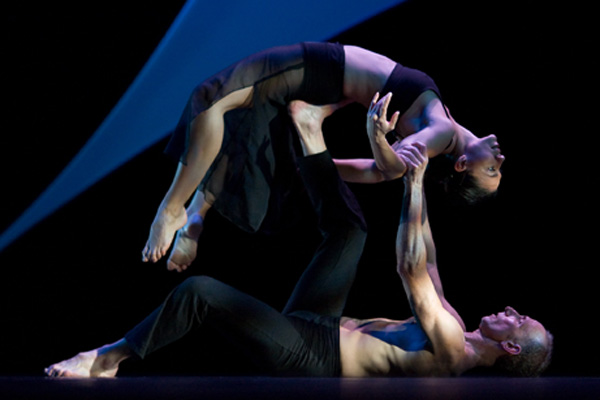
Stay the Hand envisions peace
By Sheila Orysiek
SAN DIEGO—The world really should be run by artists; we’d have more peace and a lot more enjoyment. It is probably the one sphere in which old disagreements might find new insights and finally cooperation. The title, Stay the Hand, comes from G-D staying Abraham’s hand just as he was about to sacrifice his son, Isaac. Beginning at a place in which all three of the Abrahamic faiths agree, is a good place to start the process of exploration and perhaps, understanding.
I saw the beginnings of this work which premiered at the Birch North Park Theatre on April 5, as a “work in progress” last year and in the interim I spoke to John Malashock about himself and his view of his choreography. Malashock explains that Stay the Hand goes beyond the bounds of religion or politics; it explores the possibilities of opposites co-existing, making the full circle to meet around on the other side.
The work is a collaboration between the choreographer and Iranian-born composer, Shahrokh Yadegari - sharing not only a Jewish heritage but a desire to blend artistic goals, aspirations and a hope for peace - by going back to a time before the present contretemps.
Sometimes differences arise from small beginnings swelling into a national as well as a cultural divide, while at other times differences are integrated peacefully into daily life, to the benefit of all. Malashock finds these possibilities artistically exciting; and even more so with Yadegari’s music which is both ancient and contemporary - another blending of opposites.
Divided into ten parts, split by an intermission, the performance was introduced by Artistic Director and Choreographer John Malashock giving some background into his thoughts and goals. A handsome printed program provided more information; pictures, biographies, history and aspirations of the company, plus the text of Persian poems which underlies the work.
The stage was bare except for two white tent like shapes stretched across a black backdrop. These were manipulated during the evening into the stage space itself, giving what initially looked to be a two dimensional design, three dimensions. This setting as well as the various costumes stayed within the black-white spectrum throughout. Costumes were pants for men, tank tops, short sleeved tops or bare chests, while the women wore calf length pants, sometimes sheer, with tank tops, short tunics, or halters - but everything stayed within the black-white design. Normally I am adverse to dark costuming against a dark backdrop - but this was so well lit, and the theatre small enough, that it was not a dim view at all.
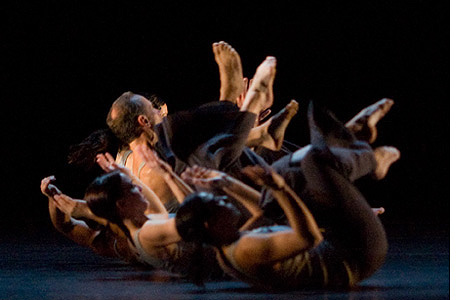 The various parts of the work generally alternated sufficiently from legato to staccato keeping the interest through the degrees of both. There were explorations of dependency through use of balance; a dancer falling off vertical depending upon another dancer for salvation - repeatedly. As a counter to this, occasionally after manipulating one another, a dancer was simply dropped as others walked away unconcerned. At times the electronic score became insistent and fraught with anger mirrored by the dancers to excellent effect. One such showed several women mourning over a dead combatant as others continued to battle ignoring the obvious outcome. The various parts of the work generally alternated sufficiently from legato to staccato keeping the interest through the degrees of both. There were explorations of dependency through use of balance; a dancer falling off vertical depending upon another dancer for salvation - repeatedly. As a counter to this, occasionally after manipulating one another, a dancer was simply dropped as others walked away unconcerned. At times the electronic score became insistent and fraught with anger mirrored by the dancers to excellent effect. One such showed several women mourning over a dead combatant as others continued to battle ignoring the obvious outcome.
One particularly evocative section was named “Tear” - which as read could mean “tear” which we associate it with emotion evinced by the eye, or it could mean “tear” as in rending something. It seemed as if this particular dance explored both meanings.
Malashock doesn’t hesitate to make his supportive work gender neutral; men lifting and carrying men, women lifting and carrying women, in addition to the more often seen presentation of men supporting, lifting and carrying women. This makes for a broader use of vocabulary and probably closer to life’s truths. At times, he has two men dancing together alongside two women - both couples doing the same thing, so one gets to see how identical choreography changes shape when executed by a male versus a female body. The steps and/or shapes then of course - though the same - look quite different.
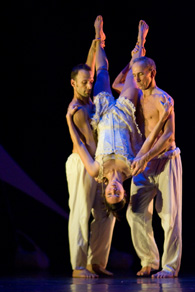 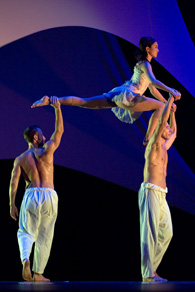 
Malashock makes good use of hands both as gesture as well as shape. He pays attention to the small details but doesn’t forget the overall picture. Sometimes it reminds me of letters of the alphabet changing place in space; each dancer forming a shape, but as one’s gaze pulls back - put together both dancers have formed a greater shape such as the letter “K” which he then slides around to form something quite different such as the letter “S.” Watching this moving transformation from both individual shape to overall effect, is captivating. Occasionally other choreographers will manipulate each dancer against negative space, but then will forget the larger picture; being busy with the trees and thus forgetting about the forest. Malashock doesn’t allow this to happen.
At times, there was a whiff of folk dance in the grape vine steps, and this served to keep the work grounded - a hint of time and place. The final dance using all eight dancers, including Malashock, was sprightly, energetic and a good finalé. The technical as well as artistic merit of the dancers was exemplary throughout and they all deserve to be named:
John Malashock, Michael Mizerany, Jillian Chu, Eduardo L. Cueto, Bradley R. Lundberg, Christine Marshall, Jessica Reed, Lara Segura.
Yadegari’s electronic score occasionally accompanied by voice was obviously the impetus for the movement, inspiring the choreographer and the dancers. The theatre provided surround sound which kept the audience in the midst of the action rather than in front of it; however, at times, the volume bordered on the brink of aural discomfort - at least for me.
This program continues with three more performances through April 13, 2008 and is certainly a worthwhile experience and one hopes these dancers will provide the kernel for a company of which Malashock spoke in his interview with me.



ADVENTURES IN SAN DIEGO HISTORY
Editor's Note: We continue our reprinting from the September 20, 1922 edition of The San Diego Jewish Community News—a benchmark edition that outlined the history of Jewish organizations in San Diego. If you have historical topics about the San Diego Jewish community you would like us to explore, please e-mail your suggestions to editor Don Harrison at sdheritage@cox.net
Ladies’ Aid Society
By Mrs. L. A. Blochman
From The San Diego Jewish Community News, September 20, 1922, page 8
The Ladies’ Hebrew Aid Society was organized on March 27th, 1890, with the following officers: president, Mrs. C. Wolfsheimer; treasurer, Mrs. Simon Levi; and secretary, Mrs. M.A. Lesem. All of these original officers have passed on, with the exception of Mrs. C. Wolfsheimer, who now resides in Los Angeles. The treasurer, Mrs. Simon Levi, held that office for thirty consecutive years, a record that in all probability cannot be equalled (sic) by any other organization. The Ladies’ Hebrew Aid Society was her life and all the energy and the love that she had were put into her work.
The amount of money in the treasury, when the Aid Society was organized, was $13.00; today, it has $875.00. Its original number of members was 20; today, there are 70, an increase not in proportion to the increase in the Jewish population of San Diego. However, it is the desire of local Jewry to have all the Jewish social agencies organize a federation with a membership of at least 350.
The object of the Ladies’ Aid Society is to render relief to the sick and needy, to rehabilitate families and to aid the orphan and half-orphan. During the past year 14 families, 39 men and 2 women were assisted, while homes were found for 3 children.
Dr. Joseph Weinberger is ever ready with medical services and Mr. Abraham Rosenthal stands at the beck and call of the society with legal advice. Enough appreciation and gratitude cannot be expressed to these men.
During the last six months, a paid worker has been employed to deal with all Jewish cases. Thanks to the Associated Jewish Charaties (sic), desk room has been secured in its building.
{Missing words here} twenty-three agencies belonging to the Community Chest and has two {missing words here}.
The Aid Society is also one of the representatives on the Community Welfare Council.
The amount expended by the Society last year was $1015; dues amounted to $294. Inasmuch as a paid worker is employed, the Community Chest was asked for the difference between the expenses and the dues collected, which difference was $1155.
Another piece of work of which the society is justly proud is the contribution of $75.00 to the Jewish Committee for Personal Service in State Institutions of which Dr. Martin A Meyer of San Francisco is president. The work of this committee is statewide in its scope and is most ably and efficiently carried on by Mr. Wm. Blumenthal.
Last year, a war orphan was adopted with the legacy left by Mrs. Simon Levi.
The Aid Society is a member of the National Conference of Jewish Social Service which met last June 18th in Providence, Rhode Island. Our representatives at the conference were Rabbi and Mrs. Maxwell Dubin.
The California State Conference of Social Work met in San Diego, April 25-28 this year. A poster displayed by the Ladies’ Aid Society, attracted a great deal of attention and favorable comment.
It is hoped that the dream of a Federation of Jewish Charities in San Diego will be realized before the close of this year, so that the work maybe carried on in the best, the most scientific and the most extensive way.
The Jolly Sixteen
By Mrs. L. Moorstein
From The San Diego Jewish Community News, September 20, 1922, page 8
One afternoon, about nine years ago, a group of women met at the home of Mrs. A. Buck and formed a little social club which was later destined to play a prominent part in the Jewish affairs of San Diego. Among those present were Mrs. Ganeles, Mrs. Schlessigner, Mrs. Rubin, Mrs. Berenson, and others, and their object was simply—“good times.”
Two years later, in 1915, the club was organized on a firmer basis—by-laws were adopted, the name “Jolly Sewing Circle” taken, membership limit of sixteen, and it was decided to do something worth while. Each member donated toward a charity fund, and officers were elected as follows:
Mrs. Meyer Rubin, President; Mrs. A. Berenson, Secretary, and Mrs. I. Rubin, Treasurer.
Since that time the club has been popularly called the “Jolly Sixteen” and hundreds of dollars have been spent in relieving the needy of this city. Not only is money given in cooperation with the Ladies’ Aid Society and other charitable organizations, but cases are personally investigated, homes visited, and persons given individual aid and attention.
Money is raised through means of card parties, dances and other affairs which have proven successful both financially and socially. These affairs are always looked forward to by the local Jewish community.
During the war, and in the relief of the European war victims since, the club has taken an active and helpful part. It has also recently adopted a little Jewish orphan in Palestine, in memory of its beloved member, the late Mrs. Leo Greenbaum.
The officers during the past year were, Mrs. J.A. Selditz, who deserves much credit for her untiring efforts during the two years she served as President; Mrs. M. Rubin, Vice President; Mrs. Lou Moorstein {the author}, Secretary, and Mrs. Meyer Rubin, Treasurer.
A number of affairs are being planned which the Jolly Sixteen hope to make among the most enjoyable of the winter season, and by which they hope to raise funds to carry on their work.
The Tuberculosis Auxiliary
By Mrs. M.L. Sokoloff
From The San Diego Jewish Community News, September 20, 1922, page 8
This organization was formed on July 16, 1921 with fourteen members. Since then it has grown consistently in members.
During the twelve month period (July 1921-22), our society gave a picnic at Imperial Beach, a dance at Liberty Hall, and a card party at the Y.M.H.A. These functions have enabled us to send nine hundred dollars to the Duarte, Calif. Sanitarium {today known as the City of Hope}.
We thank the San Diego community for the support they have given us.
The Council of Jewish Women
By Mrs. M. Schoenbrun
From The San Diego Jewish Community News, September 20, 1922, page 10
The National Council of Jewish Women with which the San Diego Section is affiliated was organized September 1893. Today it includes 192 sections in the United States, Canada and Cuba, with a total membership of over 45,000 women. The local section, Council of Jewish Women, was organized January 18th, 1921, with a membership of twenty-six, thro (sic) the earnest solicitation of Mrs. Moses Ruslander of Pittsburg. Mrs. Chas. Lowenstein was elected President and other officers were chosen.
Altho (sic) the National Council advocates many departments of useful work, it was planned that the local section should devote its energies to a few particular lines, one, that of continuing the Welfare Work among the soldiers and sailors stationed in and around San Diego, a task which had been begun during the great war. This work has been handicapped a bit thro (sic) the lack of funds and necessary support, but it is felt that despite all this, much good has resulted. The Junior Council has given unsparingly of its time and efforts to entertain the men in uniform and members of the Senior Council have visited hospitals and taken convalescents for rides and have otherwise striven to make their lot more bearable.
Nationally, the Department of Immigrant Aid is one of the biggest features of Council work. It is an ideal realized, offering as it does, protection and guidance to the unprotected immigrant woman and girl, helping to solve personal problems of immigrants under its care, and, indirectly at least, helping to solve “the problem of the immigrant,” a question so disturbing to the public at the present time. Locally, this Department has devoted its efforts more to the Americanization of the immigrant, by conducting classes in English, etc., and attempting to instill respect for and pride in this country, which has proven a haven for large numbers of immigrants.
The Department of Civics has cooperated with the Women’s Public Welfare Commission in all matters of vital throbbing interest to women as mothers and citizens. Two members of the Social Section have been appointed on that Commission, which had the privilege of sitting with the City Council at its weekly meetings.
The Program and Educational Committee has presented several splendid speakers from the various fields of work, and has, at the close of each monthly business meeting, given a program of music and a short paper dealing with the study of the Jew in English Literature, as portrayed by leading authors of all times.
What, then, has the San Diego Section, Council of Jwish Women, accomplished since its organization? Has its motto of “personal service” been well borne? Has the dignity and strength of the National Council of Jewish Women been brought home, not only to the members of the local section but to the community at large? The coming years must answer.

Please click on the schools' ads to visit their respective websites



SAN DIEGO JEWISH WORLD THE WEEK IN REVIEW
Shoshana Bryen in Washington D.C.—Why is the U.S. sanctioning the arming of Palestinians; who will be the beneficiary?
Cynthia Citron in Los Angeles: Survivor Mitzvah Project brings help, caring to elderly Jews in Eastern Europe
Donald H. Harrison in San Diego: American Jewish POW, held by Nazis, brings history alive for SDJA students
Rabbi Leonard Rosenthal in San Diego: Lingering over seder: A sign of freedom
Alan Rusonik in San Diego: Educating our students about Israel
Adventures in San Diego History: Members of San Diego's Jewish community in 1922 looked at their past, present and future.
Rabbi Michael Berk in La Jolla, California: All deaths by violence are not the same
Sherry Berlin in San Diego: A U.S. Civil War story—for Passover
Sheila Orysiek in San Diego: Chapter Two in the serialization of her novel, Reluctant Martyr
Rick Schwartz in San Diego: Seders connect family and community
And:
San Diego Builders of Israel, published by the United Jewish Federation of San Diego County in celebration of Israel's 60th year. Free download
From the Archives: Members of San Diego's Jewish community in 1922 looked at their past, present and future.
Shoshana Bryen in Washington, D.C.: Maliki's victory: Iran's big setback in Iraq
Donald H. Harrison in La Jolla, California: The thought at the Red Sea: Si, se puede!
Michelle Rizzi in San Diego: Like or hate it, Atonement garners 'Whys?'
Ira Sharkansky in Jerusalem: Violence, not settlements, blocks peace
San Diego Builders of Israel, published by the United Jewish Federation of San Diego County in celebration of Israel's 60th year. Free download
Wyman Brent in Vilnius, Lithuania: So, how will a nice Gentile boy help to restore Jewish learning in Lithuania?
Carol Davis in San Diego: Racism, anti-Semitism, sexism combine in lesbian love story at the Diversionary
Garry Fabian in Melbourne, Australia:
—Sex abuse victims urged to come forward
—Hundreds of Melburnians show solidarity with Israel
—One step closer to tax deductibility for security
—Canberra to fund Australian-Israeli medical research
—Australia reaffirms support for Israel
Alex Grobman in Englewood, New Jersey: Rabbi Herbert Friedman, founder of Wexner Heritage Foundation, dies at 89
Donald H. Harrison in La Jolla, California: Sha'ar Hanegev citizens familiarize themselves with Reform Judaism
Eileen Wingard in San Diego: A Jew and Muslim to make music together
Donald H. Harrison in San Diego: Fictional Israeli P.I. fails 'memorable' test
Sheila Orysiek in San Diego: What music performance means
Gary Rotto in San Diego: My, how San Diego AIPAC has grown
Dorothea Shefer-Vanson in Mevasseret Zion, Israel: Britain's descent into anti-Semitism
From SDJA Student Quarterly, reviews by students:
Harry Doshay in San Diego: Anthology's linup thrills jazz fans
Alexa Katz in San Diego: Mesquite Restaurant: A gem in Scripps Ranch
Michelle Rizzi in Del Mar: Pannikin: The Anti-Starbucks
Shoshana Bryen in Washington, D.C. South America's growing terrorist threat
Cynthia Citron in Los Angeles: Production celebrates Albert E, musically
Kathi Diamant in San Diego: My quest to solve a literary mystery
Donald H. Harrison in San Diego: Sha'ar Hanegev seeks rocket-proof school
Rabbi Dow Marmur in Jerusalem: Some advantages to a peace with Syria
Sheila Orysiek in San Diego: Miller's needle: Revenge in a tailor shop
Link to previous editions
< BACK TO TOP
|
|

 —
—